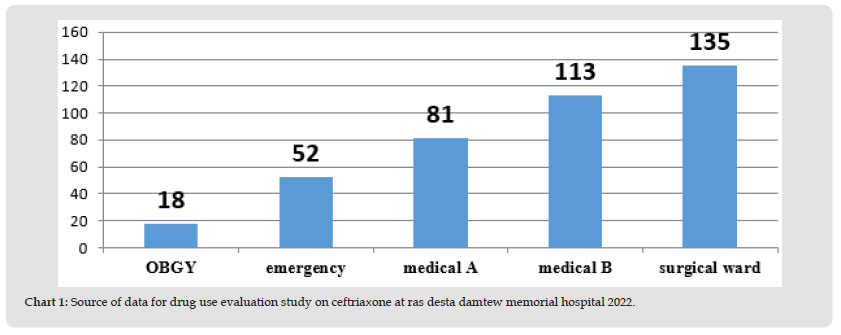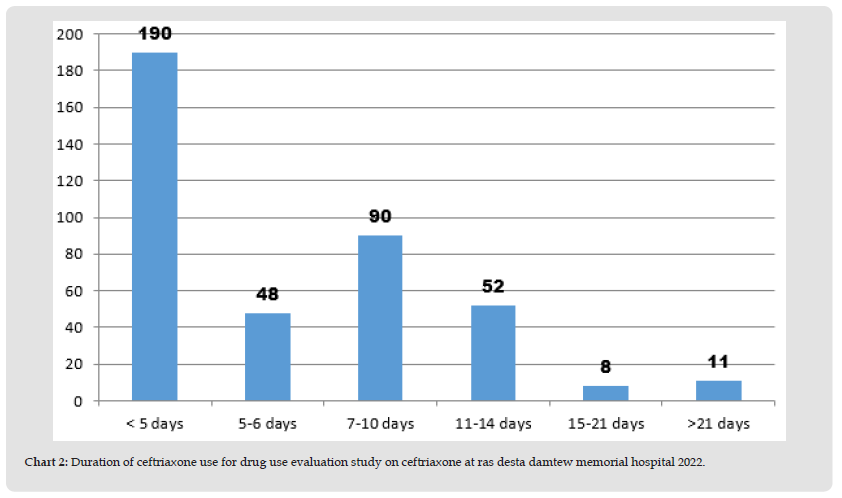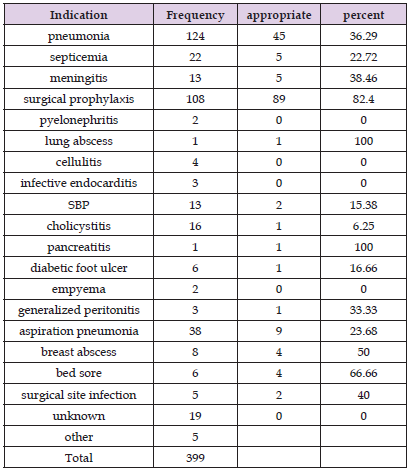Impact Factor : 0.548
- NLM ID: 101723284
- OCoLC: 999826537
- LCCN: 2017202541
Azeb Werede1, Duresa Endalew2*, Eden Habte3, Getahun Derso4, Hailu Desalegn5, Sara Mamo6, Sirgut Asrat7, Teshome Hunde2 and Yitbarek Hailu1
Received: April 11, 2023; Published: April 26, 2023
*Corresponding author: Duresa Endalew, Department of research and training Ras Desta Damtew memorial hospital, Ethiopia
DOI: 10.26717/BJSTR.2023.50.007889
Background: Infectious diseases are the most common causes of morbidity and mortality in developing countries, to control infectious diseases, antibiotics are used. The use of antimicrobial agents is showing a dramatic change globally. Rational drug use is defined as “a right drug, in right dose, at the right time, in right strength, to the right patient, right administration, and with a right cost.
Methods: facility based retrospective cross sectional study was conducted in Ras Desta Damtew memorial hospital on 399 patient records who were admitted from March 1 2019 up to February 28 2020. Single population proportion formula was used to determine sample size, patient records were selected by systematic sampling method and semi structured questioners were used to collect the data. Epi info and SPSS were used to enter and analyze data respectively.
Result: The mean age of participants were 45.53, with SD of ± 18.67 years ranging from 15 to 90. From all study participants 254 (63.7%)has concomitant disease and 396 (99.2%) has other drugs coadministered drugs with ceftriaxone, from all study participants most of them (95.5%) took ceftriaxone 1G IV BID, 110 study participants have received ceftriaxone while there is drug-drug interaction. From all study participants 124 patients took ceftriaaxone for pneumonia indication, from all ordered ceftriaxone for different indications only 43.14% is appropriate regarding indication, contra indication, duration, dose and frequency./p>
Conclusion: study revealed that inappropriate use of ceftriaxone is high when measured against STG. This could result in increased resistance and more complicated management of infections, which could lead to death and catastrophic expenditures, let alone burden the health system as a whole. The inappropriate utilization of ceftriaxone may also compromise patient safety.
Keywords: drug use, ceftriaxone, Ras Desta
In developing countries, infectious diseases are the most common causes of morbidity and mortality. Antibiotics represent approximately 30% of acute care hospitals drug expenditure and are prescribed for 20-50% of inpatient. Use of antibiotics has contributed to the dramatic fall in morbidity and mortality from communicable and infectious disease over the last 50 years globally [1]. The use of antimicrobial agents is showing a dramatic change globally, with a recorded increase by 65% between 2000 and 2015, from 21.1 to 34.8 billion defined daily doses [2]. Ceftriaxone is a broad-spectrum third generation cephalosporin antibiotic for intravenous or intramuscular administration. It is one of the most commonly used antibiotics due to its high antibacterial potency, wide spectrum of activity and low potential for toxicity [3]. The wide spread of misuse together with the emergence of antimicrobial resistance and escalating unwanted expenditures have resulted in antimicrobials being the drug most frequently chosen for drug use evaluation (DUE) studies [4].
Despite strenuous efforts to control their use and promote optimal prescribing, practitioners still continue to prescribe excessively. But, the inevitable consequence of the widespread use of antimicrobials and extended duration of use, use of suboptimal doses and longer stay in hospitals are additional risk factors that have contributed to the emergence and dissemination of antimicrobial resistance [5]. Ceftriaxone is the most frequently used antibiotics in Ras Desta Damtew Hospital both in daily dose base and in full treatment. Although Ceftriaxone is not first line drug for top ten diseases of the hospital, it accounts the lion share of the budget, moreover there are no studies conducted about the evaluation of antibiotics use in hospital wards. Therefore, this study is designed to evaluate use of ceftriaxone which is the most commonly prescribed antibiotics in medical wards of Ras Desta Damtew Memorial Hospital (Chart 1).
Figure 1 Sagittal T2 weighted (a) and T1 weighted (b), coronal T2 weighted (c) and T1 weighted (d) MR images of the pituitary gland showing an empty sella turcica (arrows) with no visualization of the anterior pituitary, posterior pituitary and pituitary stalk.

To assess the utilization of Ceftriaxone in Ras Desta Damtew Memorial Hospital from 1 March 2019 up to February 30, 2020.
Study Area, Design and Period
The study was conducted in Ras Desta Damtew Memorial Hospital which is located in Addis Ababa. The hospital was established in 1924 E. C. It has a total of 153 beds, organized by 42 case teams. In addition to the general medical service given to the population in the catchment area, the hospital serves as teaching and training center for different health professionals. The hospital has 8 pharmacy units; outpatient pharmacy, inpatient pharmacy, ART pharmacy, paying pharmacy and compounding units. The hospital has a total of 5 pharmacy case teams. A hospital-based retrospective cross-sectional study was conducted the medical records of patients who were admitted in the hospital from 1March 2019 to February 30, 2020 were reviewed. Sample Size and sampling procedure The required sample size was determined by using a single population proportion sample determination formula considering the following assumptions (Chart 2).
Figure 2 Chart 2: Duration of ceftriaxone use for drug use evaluation study on ceftriaxone at ras desta damtew memorial hospital 2022.

P= 51.1% (6).

(1.96)2 × 0.511 × (1 − 0.511)/ (0.05)2 = 385.5 ~ 386 and we add 10% for contingency
The final sample was 386 + 39 = 425
Since the total population is less than 10,000 we used correction formula
I.e. n / 1+ (n/N) 425 / 1+ (425/6518) = 399 was the final sample size.
Data Collection and Analysis Procedures
Semi structured questionnaire was used. The questionnaire includes modules on respondent socioeconomic characteristics, information on health service utilization. Data collection tools development was mainly based on the issues the study wishes to investigate. After the collected data checked for consistency and completeness, was entered into Epi data Version 3.5.1 and was analyzed using SPSS version 25. Descriptive statistics was calculated and finally obtained results were presented by using simple frequency tables, graphs and charts.
A total of 399 data were reviewed from different departments from these 199 were male 200 were female. The data was collected from 5 major wards i.e. emergency, medical ward A medical ward B, surgical ward and OBGY wards. The mean age of study participants were 45.53, with SD of ± 18.67 years ranging from 15 to 90 years. From all study participants 254 (63.7%) has concomitant disease and 396 (99.2%) has other drugs co administered drugs with ceftriaxone. From all study participants at least one lab investigation is done for 334 (83.7%) participants (Table 1). Most of the study participants (110) have received ceftriaxone while there is drug- drug interaction from this furosemide (76) followed by warfarin (33) and aminoglycoside (1) respectively. Appropriateness of ceftriaxone administration is measured from four angles i.e. duration, contra indication, does and frequency. In general from all ordered ceftriaxone for different indications only 43.14% is appropriate regarding indication, contra indication, duration, dose and frequency.
Table 1: Concomitant disease status, other IV drugs co administration and laboratory investigation for drug use evaluation study on ceftriaxone at Ras Desta Damtew memorial hospital 2022.

This retrospective cross sectional study was designed to systematically assess the appropriateness of ceftriaxone use in Ras Desta Damtew memorial hospital. In this study, the appropriateness of ceftriaxone utilization was evaluated against STGs. In this study, the inappropriate use of ceftriaxone was noted in more than half (56.86%) of patients. The result of this study is inline when compared to a study conducted in Hayat General Hospital (55.4%) and Veteran Hospital in the United States (53%),26 [6,7]. This result is better when compared to studies conducted in eastern Ethiopia (70.1%), Gondar University Referral Hospital (80.2%) and Dil Chora Referral Hospital (80.46%) [8-10]. The reason for the discrepancy could be that, unlike this study, the above studies were conducted in referral hospitals in which treatment is complicated with several possible inappropriate medication uses. In the other hand the result of this study is a higher when compared to studies conducted in Uganda (32.1%), in Korea (34.5%), Port of Spain, and Trinidad (38%) [11-13] (Table 2). The differences in the score for inappropriate use could be attributed to factors such as country differences in the STGs, differences in prescribers’ qualifications and experiences, the extent of training of healthcare workers on the use of STGs, and the assessment protocols used. Inappropriate ceftriaxone use was largely due to inappropriate dispensing, inadequate laboratory testing, wrong indications, wrong doses, and wrong dose duration. In this study ceftriaxone was ordered without any laboratory investigation for 16.3% of patients. This problem was also entertained in THAS in which (53.2 %) of the patients received ceftriaxone without lab test [14] (Table 3).
Table 2: Indication of ceftriaxone for drug use evaluation study on ceftriaxone at Ras Desta Damtew memorial hospital 2022.

Table 3: Appropriateness of ceftriaxone administration for drug use evaluation study on ceftriaxone at Ras Desta Damtew memorial hospital 2022.

Drug use evaluation of ceftriaxone with respect to indication, duration of therapy, and frequency of administration was conducted in the hospital. Our study revealed that inappropriate use of ceftriaxone is high when measured against Ethiopian STG. This inappropriate use could result in increased resistance and more complicated management of infections, which couldF lead to death and catastrophic expenditures, let alone burden the health system as a whole. The inappropriate utilization of ceftriaxone may also compromise patient safety.
All embracing effort to decrease inappropriate use of antibiotic and to raise of awareness of prescribers via implementing awareness creation programs is recommended. Prescriber should adhere to national protocol and current evidence-base guidelines and should restrict ceftriaxone only for proven infections. The hospital should also realize continuous and ongoing drug use evaluation, improve the suitability of antibiotics use through the intensification of programs like establishing an antimicrobial stewardship program, strengthening the DTC unit and capacitate clinical pharmacists in monitoring issues related to drug therapy.
The retrospective nature of the design was a bottleneck in extracting the required data from medical records. In addition, the evaluation was relied merely on the patients’ medical records for which practices might have actually been different.
First of all we would like to acknowledge Ras Desta Damtew hospital management for giving us this opportunity we also want to express our heartfelt gratitude the hospital DTC committee for their support al last but not we would like to extend our appreciation to the hospital community for their un reserved support in all aspect of completing this project.
The authors has no conflict of interest.


